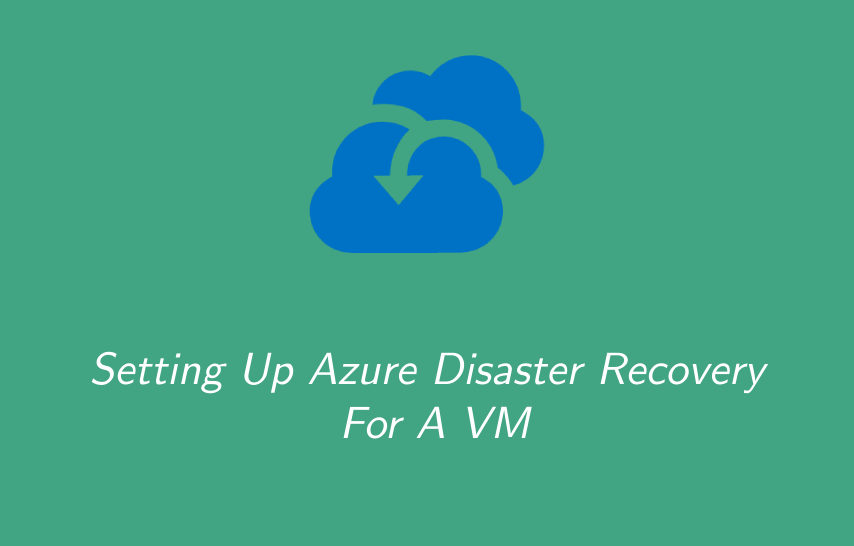In this post I will configure Azure Backup and Azure Disaster Recovery for a single VM. This can be applied on a larger scale but for brevity of this post I am keeping it simple.
It is a basic VM with nothing special on it in a 10.0.0.0/24 vnet based in East US. Here are the full details for the interested.
{
"name": "srvm01",
"id": "/subscriptions/74d08291-6d35-4784-b979-73703c8e7063/resourceGroups/MoulderSR/providers/Microsoft.Compute/virtualMachines/srvm01",
"type": "Microsoft.Compute/virtualMachines",
"location": "eastus",
"tags": {
"costCenter": "Production",
"department": "Infrastructure"
},
"properties": {
"hardwareProfile": {
"vmSize": "Standard_B1s"
},
"provisioningState": "Succeeded",
"vmId": "6fe16280-84a7-46bd-b5b5-61cbf7e89d33",
"additionalCapabilities": {
"hibernationEnabled": false
},
"storageProfile": {
"imageReference": {
"publisher": "MicrosoftWindowsDesktop",
"offer": "Windows-10",
"sku": "win10-22h2-pro-g2",
"version": "latest",
"exactVersion": "19045.4894.240906"
},
"osDisk": {
"osType": "Windows",
"name": "srvm01_OsDisk_1_62d9584765034984b3c7c4d6a4e07598",
"createOption": "FromImage",
"caching": "ReadWrite",
"managedDisk": {
"storageAccountType": "StandardSSD_LRS",
"id": "/subscriptions/74d08291-6d35-4784-b979-73703c8e7063/resourceGroups/MoulderSR/providers/Microsoft.Compute/disks/srvm01_OsDisk_1_62d9584765034984b3c7c4d6a4e07598"
},
"deleteOption": "Delete",
"diskSizeGB": 127
},
"dataDisks": []
},
"osProfile": {
"computerName": "srvm01",
"adminUsername": "CameronMoulder",
"windowsConfiguration": {
"provisionVMAgent": true,
"enableAutomaticUpdates": true,
"patchSettings": {
"patchMode": "AutomaticByOS",
"assessmentMode": "ImageDefault",
"enableHotpatching": false
}
},
"secrets": [],
"allowExtensionOperations": true,
"requireGuestProvisionSignal": true
},
"securityProfile": {
"uefiSettings": {
"secureBootEnabled": true,
"vTpmEnabled": true
},
"securityType": "TrustedLaunch"
},
"networkProfile": {
"networkInterfaces": [
{
"id": "/subscriptions/74d08291-6d35-4784-b979-73703c8e7063/resourceGroups/MoulderSR/providers/Microsoft.Network/networkInterfaces/srvm01668",
"properties": {
"deleteOption": "Delete"
}
}
]
},
"diagnosticsProfile": {
"bootDiagnostics": {
"enabled": true
}
},
"licenseType": "Windows_Client"
}
}If you’re not patient like me, once you create the VM just wait a few minutes before going to the Site Recovery tab. The VM Agent status needs to be Running before Azure lets you configure Site Recovery. Once ready we get the below. Notice how Azure demonstrates where the VM will failover to. I’ve picked Qatar to help show what Azure is going to do but realistically I would want to use something along the lines of East US 2 or West US.

On the following screen I am asked about the properties I want to give the newly deployed VM. By default Azure will append -asr to your resource group and vnet names of the failed resources. Since I only have a very basic VM, I won’t change anything and will leave tje availability to just a single instance but do note that you can deploy to a new set of availability zones and to a VM scale set.

To use Azure Disaster Recovery you need a Recovery Services Vault. If you do not have one, Azure will create one for you on creation of the Disaster Recovery policy. You’ll be able to adjust how often snapshots will be made of the VM
All together now….

So now I have a new resource group Site-recovery-vault-RG with a storage account, automation account running the retention policy replication and the site recovery vault
To clean up I simply disable replication:
- – The source replication settings are cleaned up automatically.
- – The Site Recovery extension installed on the VM during replication isn’t removed.
- – Site Recovery billing for the VM stops.
To disable replication, perform these steps:
On the Azure portal menu, select Virtual machines and select the VM that you replicated.
In Operations, select Disaster recovery.
From Overview, select Disable Replication.

